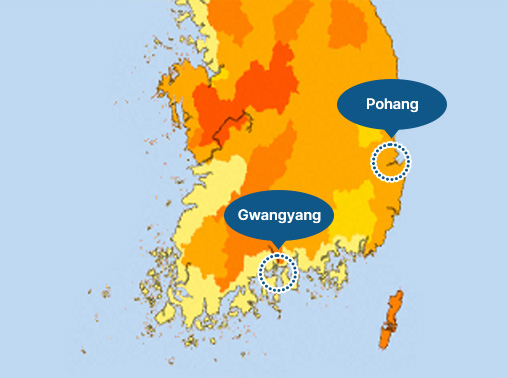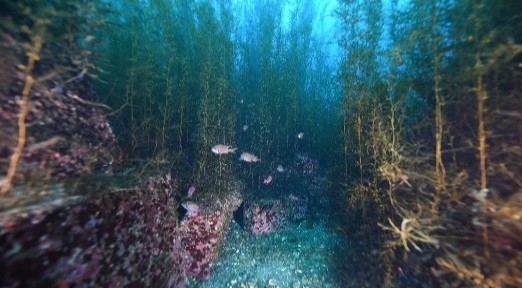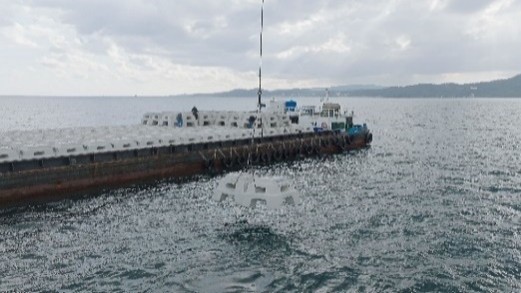Biodiversity
TNFD
OSCO recognizes global conventions and guidelines on biodiversity and land protection, including those of the Taskforce on Nature-Related Financial Disclosures (TNFD)1). We conduct ecological surveys around our business sites to prevent biodiversity loss and minimize environmental impact. At our Pohang and Gwangyang Works, we carry out pollution surveys on water quality and sediment conditions in nearby marine areas, and when necessary, engage third-party experts to conduct specialized biodiversity assessments. When developing new business sites, we identify protected areas and endangered species in surrounding regions and use this information to establish, implement, and monitor biodiversity management plans for each project.
We do not operate in protected biodiversity areas or wetlands. When offsetting or restoring nature affected by our operations, we seek to apply Best Available Techniques (BAT) or other recognized best practices.
1)The Taskforce on Nature-related Financial Disclosures (TNFD) is a global initiative that promotes the quantification and disclosure of financial impacts—both risks and opportunities—related to natural capital, such as biodiversity, air, water, and minerals.
Assessment and Management
Biodiversity Risk Analysis Procedure
| STEP 1 | STEP 2 | STEP 3 |
STEP 4 |
STEP 5 |
|
|---|---|---|---|---|---|
| Steps | Industry-Specific Biodiversity Dependency and Impact Analysis | Identification of Biodiversity Status Near Worksites | Assessment of Site-Specific Biodiversity Risks |
Identification of Natural Capital Risks |
Monitoring of Biodiversity Status |
| Activities | Analyze the steel industry’s dependency on and impact to biodiversity using the ENCORE1) tool | Identify IUCN-designated endangered species, UNESCO World Heritage sites, and nearby habitats adjacent to the worksites | Assess biodiversity risks near the worksite using the WWF’s Biodiversity Risk Filter (BRF) |
Produce a comprehensive analysis of biodiversity risks |
Monitor, report, and review biodiversity Status |
1)ENCORE is a tool that analyzes the types of natural capital businesses rely on and assesses the degree to which industry-specific activities impact the environment.
Steel Industry’s Dependency and Impact on Natural Capital
POSCO conducted a preliminary analysis of the steel industry’s dependency and impact on biodiversity-related natural capital using the ENCORE tool. Among the 20 items analyzed, 11 were identified as having medium or higher levels of dependency and impact1).
1)ENCORE classifies industry-specific dependencies and impacts on natural capital across five levels: very low, low, medium, high, and very high.
Biodiversity Dependency and Impact Analysis
| Category | Metric | Level | |
|---|---|---|---|
| Dependency | Supply Service | Water supply | High |
| Mitigating and Adjusting Service | Rainfall pattern regulation | Medium | |
| Water purification | Medium | ||
|
Water flow regulation |
High |
||
|
Flood mitigation |
Medium |
||
|
Impact |
Pressure |
Disturbance |
Very High |
|
Emissions of GHG |
High |
||
|
Emissions of non-GHG air pollutants |
High |
||
|
Generation and release of solid waste |
Medium |
||
|
Emissions of toxic pollutants to water and soil |
Very High |
||
|
Volume of water use |
Medium |
||
Status of Endangered Species Near Worksites
Based on the IUCN Red List, POSCO identified endangered species within a 5-kilometer radius of the Pohang and Gwangyang Works. The Red List categories—Vulnerable(VU), Endangered (EN), and Critically Endangered(CR)—represent species at risk of extinction. Among the species identified, fish accounted for a significant proportion of the endangered species found near both worksites.
· Analysis Timing
- POSCO updates its IUCN Red List database every year in April and May. The list is filtered by Red List categories—VU, EN, and CR—and is classified by species group.
· Analysis Method
- [Red List Category] Select VU(vulnerable), EN(Endangered), CR(Critically Endangered)
- [Land Region] Select East Asia > Republic of Korea
Number of Endangered Species (IUCN Red List)
| Worksite | Vulnerable(VU) | Endangered(EN) | Critically Endangered(CR) | Total |
|---|---|---|---|---|
| Pohang | 34 | 20 | 1 | 55 |
| Gwangyang | 43 | 31 | 4 | 78 |
| Worksite | Mammals | Birds | Reptiles | Amphibians | Fish | Mollusks | Plants | Fungi | Others |
|---|---|---|---|---|---|---|---|---|---|
| Pohang | 5 | 16 | 2 | - | 25 | 1 | 4 | 1 | 1 |
| Gwangyang | 6 | 20 | 2 | 1 | 39 | 1 | 3 | 1 | 5 |
As shown above, POSCO annually updates its biodiversity dataset between April and May, using ENCORE analysis results to identify and disclose key factors aligned with WWF’s Biodiversity Risk Filter (BRF). Based on the dependency and impact indicators identified through ENCORE, we assess biodiversity risks in areas surrounding our business sites. The BRF is applied to regions where the steel industry demonstrates a medium or higher level of dependency on and impact to natural capital.
To comprehensively evaluate the health of local ecosystems and the effects of our business activities, we analyzed risks from two perspectives: Pressures on Biodiversity1) and Regulating & Supporting Services2). These assessments guide our efforts to mitigate risks and enhance the delivery of ecosystem services.
1)”Pressures on Biodiversity” refers to indicators that reflect ecosystem health, including risks to air, water, soil, and humidity. Lower risk levels represent a more stable ecosystem.
2)”Regulating & Supporting Services” are benefits derived from natural capital, including clean air, water, and mineral resources.
Regional Biodiversity Risk Factors
| BRF Indicators | Risk Level (by Region) | ||||
|---|---|---|---|---|---|
| Pohang | Gwangyang | ||||
| Pressures on Biodiversity | Land, Freshwater and Sea Use Change |
|
|||
| Forest Canopy Loss | |||||
| Invasives | |||||
| Pollution | |||||
| Biodiversity Risk Reduction and Ecosystem Service Enhancement |
Soil Condition |
|
|||
| Water Condition | |||||
| Air Condition | |||||
| Ecosystem Condition | |||||
| Pollination (Pollen Vector) |
|||||
-

Pressures on Diversity
-

Biodiversity Risk Reduction and Ecosystem Service Enhancement
To study the marine ecosystems near our business sites, POSCO conducts annual surveys focusing on the lower tiers of the ecosystem pyramid, including zooplankton and phytoplankton, attached macroalgae, and benthic animals, which play a vital role in ecosystem health. In 2024, the number of species surveyed was expanded from four to eight.
As a result, 392 and 320 species were identified in the waters near Pohang and Gwangyang, respectively.
The surveys are conducted twice a year—in winter and summer. However, due to higher variability in summer data, we report the number of identified species based on the winter survey, which provides more consistent and reliable results.
Ecological Survey Results of Marine Species Near Steelworks (2024)
| Area | Phytoplankton | Zooplankton | Fish Roe |
Larval Fish |
Seaweeds |
Attached Benthos |
Macrozoobenthos |
Nekton |
Total |
|---|---|---|---|---|---|---|---|---|---|
| Pohang | 30 | 30 | 0 |
0 |
51 |
63 |
207 |
11 |
392 |
| Gwangyang | 29 | 18 | 1 |
0 |
39 |
44 |
185 |
4 |
320 |
Risks and Mitigation by Environmental Impact Factors
Environmental Impact Assessment at Major Business Sites
| Site status | Biodiversity Risk Factors |
Status Near Worksites |
|||||
|---|---|---|---|---|---|---|---|
| Region | Area | Land Use | Overfishing |
Pollution |
Invasives |
Climate Change Acceleration |
UNESCO |
| Pohang | 9.5㎢ | Site prepared for facility expansion | - |
[Air] Pollutant emissions |
4 invasive species observed near Pohang Works |
[GHG emissions] |
None |
| Gwangyang | 21.4㎢ |
None |
|||||
Activities to Reduce Negative Biodiversity Impacts
| Category | Impacts and Risks | Major Mitigation Activities |
|---|---|---|
| Biodiversity Mitigating impacts |
Greenhouse gas emissions |
|
| Atmosphere |
|
|
| Water Quality and Shortage |
|
|
| Waste |
|
Conservation and Enhancement
To restore marine ecosystems and promote the circular use of by-products, POSCO has been producing Triton reefs—artificial seaweed structures made using steelmaking slag—for over 10 years. These reefs are applied to areas affected by sea desertification to create sea forests and support ecological restoration. Triton reefs are rich in minerals such as calcium and iron, which are beneficial to marine ecosystems and effective in promoting algae growth, thereby helping prevent ocean desertification. To date, POSCO has installed approximately 8,000 Triton reefs along Korea’s coastal regions where sea desertification is in progress. Post-monitoring of sea forests established in Ulleungdo and Pohang subsequently confirmed an increase in ecological species, demonstrating the reefs’ effectiveness in biodiversity restoration. POSCO’s marine ecosystem restoration efforts have gained international recognition. In 2023, POSCO became the first company from Asia to receive the Environmental Innovation Award at the International Corporate Citizenship Conference (ICCC).
In April 2024, POSCO signed a public-private agreement with the Ministry of Oceans and Fisheries(MOF) to restore a severely desertified marine area near its project site. Subsequently, in November, POSCO and MOF installed Triton reefs in the waters near Gupyeong 1-ri and Mopori, creating a sea forest covering approximately 229 hectares—the size of 320 soccer fields. POSCO plans to continue follow-up monitoring to evaluate the impacts on desertification reversal, coastal ecosystem recovery, and blue carbon absorption. In parallel, we aim to collaborate on research initiatives to pursue international certification of blue carbon from seaweed and other sea forests.


